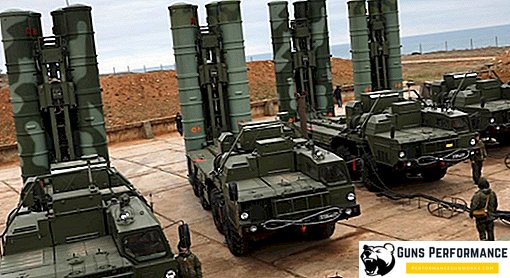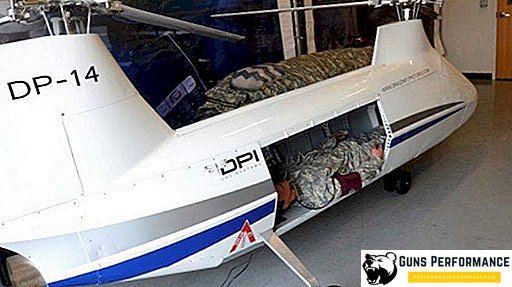Since the second half of the 20th century, space has become one of the priority areas of human activity. In just over sixty years, mankind has made a giant leap in the field of space exploration, moving from visual and theoretical observations to applied science. At first, thanks to the development of science and technology, people on rockets managed to penetrate the near-Earth space. In the future, new technologies allowed a person to start closely studying the Solar System, reach the planets closest to us and look into the abyss of the Universe. Now we know that our planet Earth, this tiny world, is too small and defenseless, that outer space is in fact a very complex, constantly changing system. Many of the advances in space exploration are the result of many years of activity by NASA - the American Aerospace Agency.

NASA history and first attempts to comprehend space
The second half of the 20th century is associated with the start of the space race, unprecedented in scale and scope, by the scientific and technical competition of two superpowers - the USA and the USSR. In the Soviet Union, this direction was entirely at the mercy of the military, but behind the ocean for these purposes a special structure was created - a state institution. In space exploration, the Americans decided to go another way, planning to create their own space agency, which would unite the efforts of the state machine, science and national economy.

At the end of the 50s in the United States at the government level, it was decided to create a specialized structure - the National Aeronautics and Space Administration, hereafter NASA. This is the abbreviation of this organization. The activities of the newly created organization was administered by the US government.
We can not say that the space agency NASA was created from scratch. Back in 1915, the National Committee on Aeronautics began its work in America. In the following years, a number of non-governmental organizations and government agencies involved in the study of outer space appeared. It was necessary to use the accumulated experience of specialists of the National Committee for Aeronautics in the field of rocket science, who in 1946 were able to create the world's first supersonic Bell X-1 aircraft, with maximum benefit. In those years, jet aircraft and rocket technology became a priority direction in the development of technology.
On the basis of the National Aeronautics Committee, work was carried out on the creation of artificial earth satellites, the development of a program of manned suborbital flights and the subsequent flight of a spacecraft with a man on board.

The reason for the revision of its national space program were the successes of the Soviet Union. The launch on October 4, 1957 of a Soviet rocket with an artificial satellite on board launched the space race. The response to this step of the Soviets was the signing in late July 1958 by US President Dwight Eisenhower of the Decree on the establishment of a national aerospace agency. Space exploration and related technologies have moved from the category of science and technology to political confrontation, becoming in subsequent years a catalyst for the confrontation of two superpowers on the world stage.

The new organization was the first of its kind, in charge of the entire space industry. Much later, similar structures began to appear in other countries, when NASA already had extensive experience. The headquarters and main office of the National Office are located in the capital of the country, in Washington. The state of direct activity was the state of Florida, where Cape Canaveral had developed launch sites. Already in October 1958, only 10 days after the official date of formation of the new control, the first Pioneer-1 spacecraft was launched. From this point on, the real work and history of NASA began, which will become an important page in the history of human exploration of near-Earth space and the subsequent study of the planets of the solar system.

Initially, the staff of the new organization consisted of 900 employees, distributed in several departments and divisions. However, in 1965, the space agency staff numbered 2500 people. In 1965, the Center for Flight Control in Houston and the new space center, the Kennedy Space Center, were added to the main objects operated by NASA. Currently, the number of employees of NASA is 18 thousand people. The number of departmental facilities scattered throughout the United States and located outside the country is more than 1,000. The budget of this largest governmental scientific and technical organization, according to data for 2018, is more than 20 billion US dollars.
Today, NASA is the main coordinator of all national programs for the peaceful exploration of outer space, a participant in many international projects aimed at studying the objects of the solar system. NASA research topics cover a huge layer of modern science and technology, allowing you to put into practice the most complex projects.

Structure of the world's largest scientific and technical institution
Starting its work as a successor to the National Aeronautics Committee, over the years of its existence, NASA has become a powerful state structure. Today it is a whole network of research centers and laboratories operating under the auspices of NASA and under the auspices of government organizations. A number of major scientific institutions around the globe work with the US space agency on a branch basis. The organization itself has a powerful scientific and technical potential. NASA research is conducted in four areas at once:
- space exploration;
- studies of the human body during its stay in unearthly conditions;
- research of our planet;
- development of promising projects based on new technologies and their subsequent implementation.

One of the main divisions of NASA is the California AMES Research Center, which develops advanced technologies in the field of astronomy, nuclear and quantum physics. Research and technical tests are constantly conducted at the center, the results of which form the basis of various projects. NASA scientists working at the DRYDEN space center are involved in designing and building aircraft and space technology. NASA airplanes created in this center are now actively involved in the study of the planet Earth, and space probes successfully surf the endless expanses of space.
NASA specialists from the research center GLENN, located in Ohio, are closely involved in the creation of rocket engines. It was their efforts that created rocket engines, which ensured the successful maneuvering and landing of the Apollo-11 lunar module. Virtually all the major projects implemented by NASA are the merit of the Goddar space center staff, who provided a study of the vast amount of information gathered in the course of near-Earth space research and astrophysical data about our planet. This center is engaged in the development of tracking systems and control over the operation of satellites in near-earth orbit. The JPL Practical Laboratory, located in the small town of Pasadena, is a place for testing jet propulsion.

The brain center and the heart of NASA is the Space Center. Johnson, located in Houston. Coordination of all space launches and flights is conducted from here, spacecraft is controlled, including control and monitoring of the situation aboard the ISS. In the central hall of this space center, the Apollo man’s moon flight program was tracked, including the landing of American astronauts directly on the surface of our satellite. All launches under the Apollo program and most other launches, as well as the launch of most artificial satellites, were carried out and continue to be carried out from the Kennedy Space Center. This huge complex consisting of factory assembly shops and numerous launch sites is located on the southern tip of the state of Florida. From here, on July 16, 1969, a giant Saturn rocket launched to the Moon, on which was the Apollo 11 spacecraft with three astronauts on board.

In addition, there are three other major research centers in the United States that are part of the National Aeronautics and Space Administration. They are actively working on the creation of promising spacecraft, creating new tracking and flight control systems. In the laboratories of research institutes and universities in the United States conducted research work under the supervision of NASA, which are then used in project implementation.
Major milestones and advances in NASA activities
NASA is one of the most significant participants in space exploration. Over 60 years of its existence, NASA experts, scientists, technicians, designers and researchers in many fields of science have implemented more than 500 different programs and projects, each of which has become an important milestone in the history of modern science.

The launch of the first artificial Earth satellite, the Piner-1 space probe, was followed by larger and larger launches and events. The rapid pace of development of astronautics in those years was explained by the presence of competition between the USSR and the USA. Yielding to the Soviet Union's primacy in launching a spacecraft with a man on board, the Americans took revenge on the Apollo project. NASA marked their victory in the space race with the Soviets by landing two astronauts on the surface of the moon on July 20, 1969. This event not only became epoch-making in the history of mankind, which demonstrated to the world the pinnacle of technical and scientific thought, but also was the apotheosis of a grandiose program that, in its scope and scale, did not have and does not have such projects in history.
More ambitious projects, which meant the creation of colonies on the moon, were to follow the landing on the satellite. In the future, the development project was curtailed. This happened for a number of reasons, most of which lie in the economic plane. Today NASA has returned to the idea of building an intermediate transit station in orbit of the moon, providing long-distance flights into space. However, experts believe that the creation of a lunar base is inexpedient.

In addition to the exploration of the moon, a number of NASA missions have become a landmark in the field of space exploration. Suffice it to recall the epic with Mariner and Voyager space probes. Thanks to these devices, man has managed not only to get closer to the secrets of our near space, but also to look beyond the objectives of ground-based telescopes. Brisk and small probes "Mariner" allowed to see Mars near. Space probes "Viking-1" and "Viking-2" successfully landed on the surface of the Red Planet, giving a person the first opportunity to look at the Martian landscapes. The spacecraft AMS "Pioneer-10" and "Pioneer-11" provided the world with new pictures of Jupiter. Together with them, only by the efforts of two other probes, Voyager 1 and Voyager 2, scientists from all over the world received the most valuable information about distant Saturn, Uranus and Neptune.
A significant step in the exploration of near-Earth space was the creation of NASA and the subsequent launch of the first Skylab space station. During the last third expedition (1973-1974) the absolute record of man’s stay in space was set at the station - 84 days.

A new record of man’s stay in space was set in 1998. Russian cosmonaut Gennady Padalka stayed in orbit for 878 days - 2 years and almost 5 months.
The beginning of the 80s was marked in the history of NASA by the beginning of a new stage in space exploration. For the first time in the history of space launches in April 1981, the Columbia reusable spacecraft went into the sky from the launch pad of Cape Kennedy. The Americans created six Shuttles, which repeatedly flew into Earth orbit. It is with the reusable space shuttle ships in the history of American cosmonautics that the first most terrible catastrophe is associated. After 73 seconds of flight on January 28, 1986, the American shuttle Challenger exploded, killing seven astronauts. After 17 years, the fate of its twin ship was repeated by Columbia. Landing, the spacecraft collapsed in the upper atmosphere of our planet. In this case, all seven crew members of a space ship were killed.

It should be noted that among the many programs implemented by NASA over the past 30 years, the research of the Red Planet is a priority. The place of Mars in the field of research of the planets of the solar system has always been significant, but in recent years there has been an increase in work in this direction.
NASA activity in our day
In addition to the preparatory program for sending an expedition to Mars, organizations are actively working on the creation of new and sophisticated aircraft. Launches of new spacecraft, created jointly with the European Space Agency and similar organizations in other countries, are now in priority. Significant successes were marked by the landing of three Mars rovers on Mars, two of which Opportunity and Curiosity continue to operate today.

During the first decade of the new century under the auspices of NASA, Cassini-Huygens, Galileo space probes and the New Horizons automatic spacecraft set off to study Jupiter, Saturn and distant regions of the Solar System. For more than 30 years, the flight has continued and at the same time the Voyager-2 space probe has been operating, having flown away from us over a distance of 17 billion km.

In terms of exploring outer space outside of our solar system, NASA experts found with the help of the Hubble Space Telescope a lot of new and previously unknown. New distant worlds were found, which, according to scientists, strongly resemble our planet. NASA is considered the undisputed leader in terms of research scope and size of participation. It is difficult to assess the contribution to the development of science and technology, which made the National Aeronautics and Space Administration.












